

Metro-Goldwyn-Mayer has long been a classic American icon, its distinguished
reputation embodied in its renowned moniker and roaring lion trademark.
Since its founding in 1924, MGM has prided itself on creating and shaping
cinematic history, delighted audiences worldwide with entertainment of
unparalleled distinction. Some of the greatest animators of all time,
including Tex Avery, Hanna
and Barbera, contributed to its success. But the studio's pinnacle
in the 30's and 40's would be followed by its decline in the 1950's, when
the animation studio was closed. Nevertheless, MGM remains today a major
force in the entertainment industry, with a proud heritage, an enduring
legacy, and a promising future.
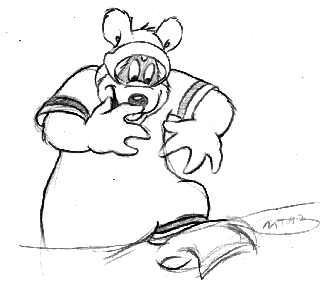 |
 |
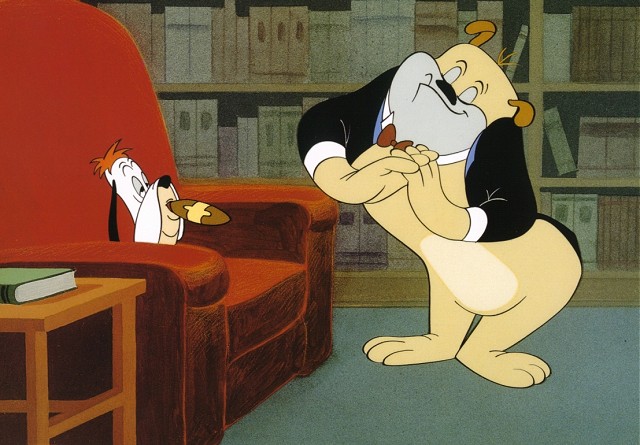 |
 |
MGM Academy Award Winning Cartoons

The birth of stars
William Hanna, an animator who had done some directing at MGM since 1937 without really impressing anyone, was coupled up with Joseph Barbera in 1939. Joe Barbera had moved to MGM, also in 1937, from Paul Terry's studio in New Rochelle to work as a story man. Hanna and Barbera somehow connected with each other and fused into a fantastic team. They complemented each other perfectly with Hanna's keen sense of timing and Barbera's creative gag writing.
 Thus
Tom and Jerry, the wonderful duo which were later to be called Metro-Goldwyn-Mayer's
"Gold Dust Twins", was born on the MGM main lot in Culver City, California
in 1939 to star in the first Hanna-Barbera directed short. The debut for
the two duos became Puss Gets the Boot, released February 10, 1940. The
featuring characters had, however, not yet received the names we know them
by. Tom was called Jasper and Jerry was merely an unnamed rodent.
Thus
Tom and Jerry, the wonderful duo which were later to be called Metro-Goldwyn-Mayer's
"Gold Dust Twins", was born on the MGM main lot in Culver City, California
in 1939 to star in the first Hanna-Barbera directed short. The debut for
the two duos became Puss Gets the Boot, released February 10, 1940. The
featuring characters had, however, not yet received the names we know them
by. Tom was called Jasper and Jerry was merely an unnamed rodent.
"The story is told that the producer, Fred Quimby, really saw nothing special in the cat and mouse and had the new directing team doing one-shot cartoons, until Puss Gets the Boot was released and became an enormous hit. It was held over at many theaters and nominated for an Academy Award."1 Another MGM short, The Milky Way directed by Rudolf Ising, won the Oscar for Best Short Subject, Cartoon that year.
At this point Hanna and Barbera returned to the cat and mouse. They christened them Tom and Jerry, and began on the second (some would say first, as Puss Gets the Boot was intended to be a one-shot) cartoon in a series that would go on for nearly 30 years at MGM alone. The result was The Midnight Snack which was based on the same basic premise as its predecessor, but made with even better gags. The good collaboration between Hanna and Barbera was obvious in all of their works. Jack Zander recalls the working method in the early days : "Joe wrote all the stories, made all the the sketches, made all the layouts, and Bill Hanna wrote the exposure sheets. Joe could sit with a pencil, and ideas would come off the end just as fast as he could move it. He could draw a storyboard so fast that it would take two people to pin the drawings up on the board while he was making them."
Still, one must not forget the exceptional animation that was classic
for Tom and Jerry during the Hanna-Barbera era. Neither should musical
director Scott Bradley be forgotten, for he had the ability to add an extra
dimension to these shorts. Just as he had done with every other MGM short
from his very start with Harman and Ising.
In 1943 the Tom and Jerry team won its first Academy Award for The
Yankee Doodle Mouse. This Oscar was the first of seven the team's cat and
mouse duo would collect in only nine years. Quite an effort and a record
never to be beaten.
The making of stars
If viewing the Tom and Jerry cartoons in order of release, one will
notice that the speed and number of gags began to increase shortly after
Tex Avery joined MGM in 1942. Avery had a way of pacing things that was
unseen before. This effected Bill Hanna and Joe Barbera, and after a time
it became a race. Thus many of the mid-1940s Tom and Jerry cartoons stand
out in the mass of shorts, with an extremely high pacing and more aggressive
gags. Of course there were shorts that didn't exactly live  up
to the MGM standards, but the overall standard of Hanna an Barbera's cartoons
was well above average.
up
to the MGM standards, but the overall standard of Hanna an Barbera's cartoons
was well above average.
The popularity of Tom and Jerry around the world is an effect of many
things. One of the key things to the success was the truly believable personalities
of the cat and mouse. People could identify with the characters. Not only
with the the good aspects but also the bad. In addition, each of the characters
possesses an incredible amount of likeability. These likable personalities
shines out to the audience in a number of different ways, for all of which
there was a certain processed basic idea. For example, one of the most
basic ideas of the Tom and Jerry series was the chase. It was a ritual,
and somehow it became clear to people that when all is said and done, Tom
has no intention of actually eating Jerry. It's not the need for food and
survival that's essential anymore. It's the chase it's all about. The thrill
of it. Tom and Jerry are no longer a cat and mouse but two persons somehow
helping each other fulfilling their needs. This underlying bond between
Tom and Jerry gives all of their cartoons strength, and it has been seen
from time to time that the two team up to get rid of some outside menace.
It's a love-hate relationship that has proven to be both durable and irresistible
at the same time.
The movies
Tom and Jerry also got to star in real movies. The first of such was the musical Anchors Aweigh starring Gene Kelly. Even though this movie was being made at MGM it was Walt Disney who was the first choice when a dancing scene with a character was planned. The story is told that when Disney heard the idea his response came quickly; "Mickey Mouse featuring in a MGM movie ? - Never !" Although Disney turned down the assignment he told Kelly that the idea was certainly feasible. Only then the idea was presented to Hanna and Barbera.
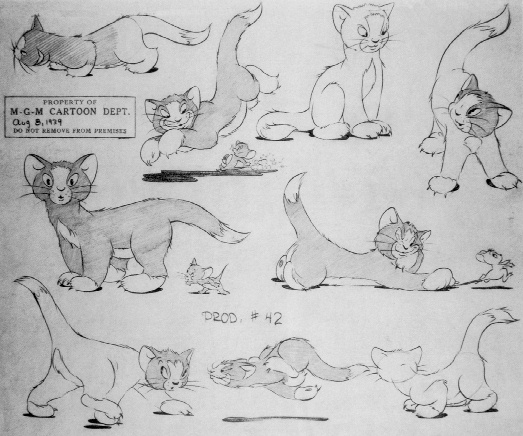 It
was a challenge, but one that all sides were equally excited about taking.
First the entire scene was scheduled on a story board. Then it was shot
with both Gene Kelly and the cameraman acting as if Jerry was in the scene
at the time. Then Kelly was rotoscoped. Thus Jerry's every movement matches
Kelly's precisely, and the outcome was superb. This sequence is one of
the technically most perfect and most entertaining in the history of movie
musicals. more to it, one of the most famous and unusual, too.
It
was a challenge, but one that all sides were equally excited about taking.
First the entire scene was scheduled on a story board. Then it was shot
with both Gene Kelly and the cameraman acting as if Jerry was in the scene
at the time. Then Kelly was rotoscoped. Thus Jerry's every movement matches
Kelly's precisely, and the outcome was superb. This sequence is one of
the technically most perfect and most entertaining in the history of movie
musicals. more to it, one of the most famous and unusual, too.
Years later Tom and Jerry were again wanted in the world of movies.
They were then to swim with Esther Williams in Dangerous When Wet. Gene
Kelly then returned in 1953 to present to Bill Hanna and Joe Barbera another
idea for his next feature film Invitation to the Dance. Kelly wanted an
entire segment of the film set on cartoon backgrounds. This segment, which
was to be called Sinbad the Sailor, was probably the greatest challenge
the animators ever got. Especially because Kelly was supposed to dance
with a serpent. This caused some problems to the animator of that particular
sequence, Michael Lah, as he found it was very difficult to make it look
like a subject is dancing without showing arms or legs. To make things
work the sequence was shot with Carol Haney imitating the serpent. Afterwards
Kelly then filmed the sequence again without her. The serpent was not traced
from Haney's movements, however. The animators had to rotoscope Kelly to
make the sequence work, and instead used Haney's dance as a seperate film
for use of reference.
Rising costs and lower budgets
In the 1950s things changed at the MGM cartoon department. Hanna and Barbera had introduced new characters to keep the Tom and Jerry series interesting to the audience. These characters had featured from time to time but in the 1950s they became much more ordinary. Little Nibbles, Little Quacker, Spike, and Tyke were the most important of these. The two latter got to star in their own series, which didn't receive much in audience response.
This decade also brought changes to the cartoon studios around the world,
and not least MGM. Costs kept growing, and Quimby had a hard time keeping
his budgets under control. Thus about once a year Hanna and Barbera would
make a cartoon where most of the footage was from earlier cartoons. These
clips would then typically be explained as chapters in a diary or the like.
The running time was restricted to a maximum of 7 minutes where shorts
of up to 11 minutes had been acceptable in the 1940s.
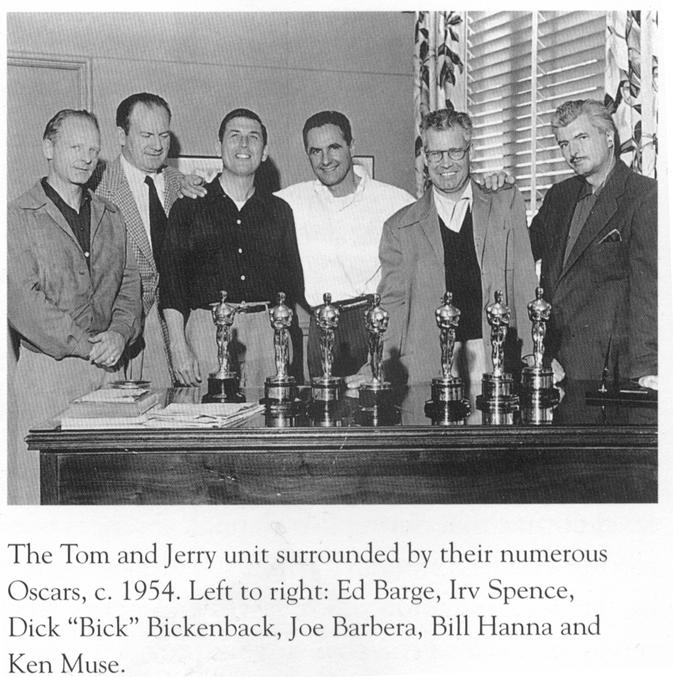
MGM had to accept one new expense, however. Cartoons in CinemaScope
became a necessity to stay competitive, and MGM released their first wide-screen
cartoon in 1954. By 1956 all their animated shorts was filmed in CS. The
animators adapted to this new technique with relative ease, but the in
betweens and inking had to be better as the screen was so large that any
flaw in the animation would become obvious. As a compensation the ink lines
became heavier and completed a process of streamlining that Tom and Jerry
had undergone during the last years.
In 1957 Metro-Goldwyn-Mayer's cartoon department was closed down without prior notice to the employees. Directors and animators oversaw the finishing touches of the cartoons that had been in mid-production when the news were told. "We didn’t have anything to do," recalls Bill Hanna. "We saw the rest of our cartoons through, but we knew they weren’t going to pick them up."
Bill and Joe then offered their idea to make low-cost television to
MGM. It is told that Metro production executive Eddie Mannix claimed there
was no future in television cartoons and therefore dismissed the thought.
The duo then formed their own production company, created Ruff and Ready,
and sold them to Screen Gems, a division of Columbia Pictures, the budget
then being only 1/15 of the minimum budget at MGM ! Thus giving birth to
limited animation.
Second thoughts
In the early 1960s it was felt there was a renaissance of interest for cartoons. Some people like to connect this as a reaction to the success Hanna and Barbera had gotten with their cartoons on television. MGM decided that Tom and Jerry might after all still be worth money on the screen. Gene Deitch, an American cartoon director, was assigned to the task of making thirteen new shorts during 1961 and 1962. He had recently moved himself and studio to Prague, and his Czechoslovakian animators had only six Tom and Jerry cartoons to use in getting to know the new characters in hand.
The animation itself is actually quite good, considering the very low budgets. The characters running across the screen still doesn't seem like Tom and Jerry, however. There is no humor, no comedy, and no characterization in these shorts. Tom and Jerry seems like charicatures of themselves, and worst of all is the soundtrack. The music sounds hollow and weighs down the cartoon as a whole, as does the sound effects. For instance, Tom getting swept off his feet would result in a sound much like one you'd get if kicking a bucket of metal ! One imagines people having quite the lot of fun doing the sounds banging pots and pans and breaking glass.
Gene Deitch had at no time had any illusions about the job, and once
told David Rider of Films and Filming magazine, "The reason Metro did them
had nothing to do with bringing Tom and Jerry to life. They simply wanted
to cash in on their popularity as cheaply as possible. Any qualities the
finished pictures have is strictly the result of the personal craftsmanship
of the artists."5 Although these cartoons were much below normal standard,
they proved to MGM that Tom and Jerry were still stars, and that cartoons
were still a source to money.
The final years
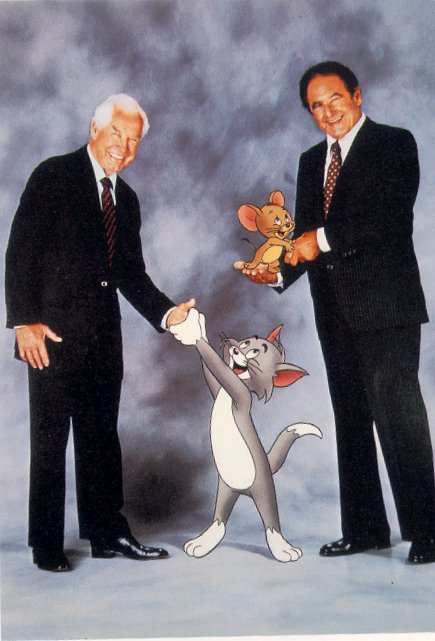 In
1963, When Warner Brothers shut down their cartoon department, director
Chuck Jones and producer Les Goldman formed their own company called Sib-Tower
12 Productions5. After doing a few projects of their own they were contacted
by MGM who offered them a contract. Jones redesigned both Tom and Jerry
to make them suitable for his sort of cartoon making. Tom was given big
eyebrows and some other smaller restructuring was made in order to make
it easier to give him looks of frustration. Jerry was given larger ears
and larger, more winsome, eyes for cuteness. The shorts that was made by
Jones was without a doubt the best of the 1960s, but still never reached
the standard of the Hanna-Barbera era. One of the most obvious reasons
for this is that Jones had no intention of using the formula consisting
of a chase and lots of violence that Bill Hanna and Joe Barbera had created.
Jones wanted to work with Tom and Jerry as he'd done with the characters
at Warner's. Unfortunately Tom and Jerry just doesn't seem to support that
type of comedy, and thus many of Jones' T&J cartoons merely became
one long series of poses and gestures.
In
1963, When Warner Brothers shut down their cartoon department, director
Chuck Jones and producer Les Goldman formed their own company called Sib-Tower
12 Productions5. After doing a few projects of their own they were contacted
by MGM who offered them a contract. Jones redesigned both Tom and Jerry
to make them suitable for his sort of cartoon making. Tom was given big
eyebrows and some other smaller restructuring was made in order to make
it easier to give him looks of frustration. Jerry was given larger ears
and larger, more winsome, eyes for cuteness. The shorts that was made by
Jones was without a doubt the best of the 1960s, but still never reached
the standard of the Hanna-Barbera era. One of the most obvious reasons
for this is that Jones had no intention of using the formula consisting
of a chase and lots of violence that Bill Hanna and Joe Barbera had created.
Jones wanted to work with Tom and Jerry as he'd done with the characters
at Warner's. Unfortunately Tom and Jerry just doesn't seem to support that
type of comedy, and thus many of Jones' T&J cartoons merely became
one long series of poses and gestures.
After 34 Tom and Jerry cartoons and 2 one-shots, MGM stopped production
in 1967 by not renewing Chuck Jones' contract, as it was the general thought
at MGM that there was no future in theatrical shorts.
Post MGM
In 1975, Hanna and Barbera, the creators of Tom and Jerry. came up with the idea of casting the cat and mouse duo in a new series for Saturday morning television. Network executives feared, however, that the violence in the cartoons would make the series banned by parents. So, it was decided that Tom and Jerry had always been backstage buddies, and that they in this new series was to be friends on stage as well. They would now solve mysteries and help others in friendly competition.
In 1989, a new Hanna-Barbera Saturday morning television series was
produced. It was called Tom & Jerry Kids, and featured Tom and Jerry
as children.
|
||||||||||||